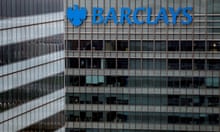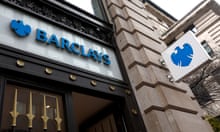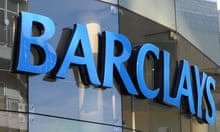Barclays has revealed a 40% slump in profits after putting aside £1.3bn to cover a US trading blunder.
The UK bank said pre-tax profits fell between April and June – from £2.5bn a year earlier to £1.5bn – falling short of the analysts’ consensus forecast of £1.6bn.
The lender was knocked by a jump in conduct costs, which increased from £143m a year earlier to £1.3bn, after it was forced to start the process of buying back US securities it had not been authorised to sell. Some of that money has been put aside to deal with the potential fine expected to be levied by US regulators over the error.
Barclays’ chief executive, CS Venkatakrishnan, announced on Thursday he had commissioned an external review of the trading blunder that would be handed to the board shortly.
“We will consider all these findings carefully and take appropriate action in response,” he said, adding that the bank “continued to engage positively” with the US Securities and Exchange Commission, which is likely to issue the financial penalty.
The bank also took a £200m charge to cover potential defaults in the second quarter, though the bulk of the charge related to its decision to buy up the credit card business of the US clothing retailer Gap.
Barclays put no extra money aside to cushion the blow of potential defaults in the UK, but said it was taking surging inflation, and its effect on borrowers facing higher bills, into account.
It came after the price of essentials including food and fuel pushed UK inflation to a 40-year high of 9.4% in June.
Barclays said it expected impairment charges linked to potential defaults to remain below pre-pandemic levels, partly due to high repayment rates on unsecured products such as credit cards, more prudent spending by customers and savings built up during the pandemic.
The bank’s chief financial officer, Anna Cross, said Barclays was keeping an eye for “tiny changes in behaviour” including whether customers were starting to rely on their overdrafts or using their credit cards to withdraw cash.
“We are not seeing any significant change behaviour at all,” Cross said on Thursday. “I think it’s because of the the rational change around their own spending patterns. But also what we saw during Covid was a real build up of savings by consumers and indeed corporates, and the [subsequent] paydown in unsecured debt.”
“They’re going into this environment in really much better financial shape than they would have been pre-pandemic,” she added.
The lender also reported a 31% slump in investment banking fees to £1.2m in the first half of the year, reflecting a slowdown in deals and takeover activity by businesses that have been concerned about the weaker economic outlook.
Barclays said it was expecting average UK GDP growth of 3.9% this year, falling to 1.7% in 2023. “There certainly there is pressure on the economy … we think therefore that growth will reduce,” Venkatakrishnan said. “Whether it’s an actual recession or not, it’s difficult to say at this moment.”
The chief executive added that the bank was also poised for a further rise in interest rates to 2.5% by the end of the year, which could further bolster its net interest margin – a key measure of profitability that accounts for the difference between what it earns from loans and pays for deposits.
Barclays has benefited from months of UK interest rate rises that have meant it is able to charge borrowers more for loans and mortgages. The lender appeared to take advantage of the outlook on interest rates when it bought the specialist lender Kensington Mortgages in a £2.3bn deal last month.
Despite the second quarter drop in profits, Barclays kept its bonus pool steady, ringfencing just over £1bn to help compensate top bankers over the first six months of the year.
The pot, which is reserved for Barclays’ best performers, will be built up over the next six months and shared among bankers and executives, including Venkatakrishnan, in the spring, when payouts are usually made.









